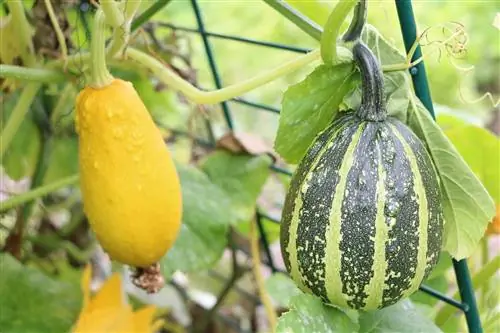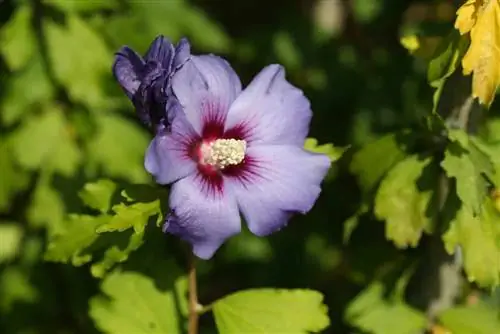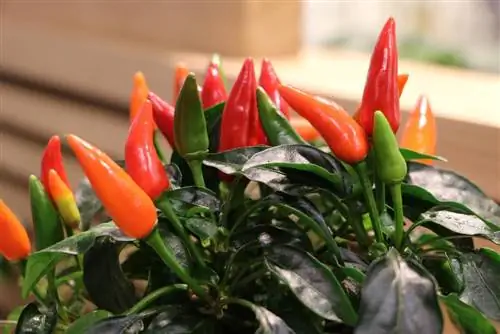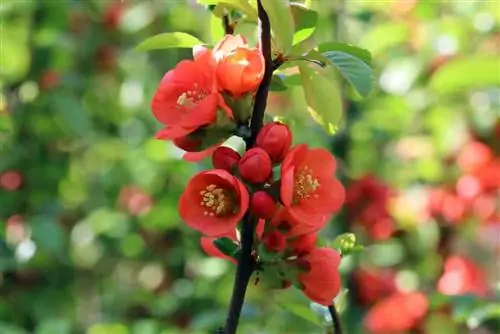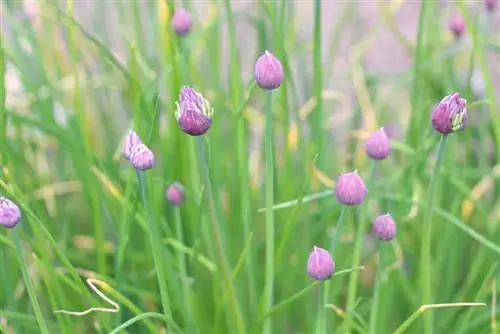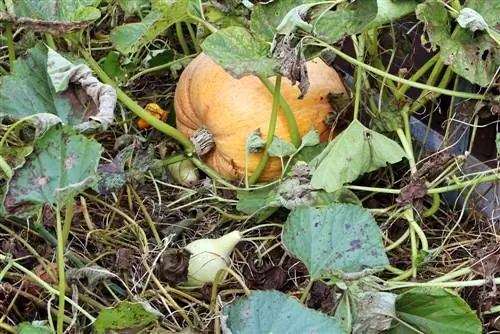- Author admin [email protected].
- Public 2023-12-17 03:39.
- Last modified 2025-06-01 06:48.
They impress with bizarre shapes and striking colors. Nobody can escape the magic of decorative pumpkins. Although the vast majority of pumpkins are perfectly digestible, various varieties are considered to be hazardous to he alth due to their high cucurbitacin content. There is still uncertainty among hobby gardeners regarding the question: Are ornamental pumpkins edible or poisonous? Closely linked to this is the issue of the joint cultivation of questionable and harmless varieties in the garden and on the balcony, which could cross each other. The following information sheds light on the matter.
Consumption prohibited - identify poisonous ornamental pumpkins
A magnificent pumpkin is in no way inferior in beauty to many ornamental pumpkins. Nevertheless, its pulp can be eaten without hesitation and is even considered a culinary delicacy. The fruits also contain healing ingredients, so pumpkin was named medicinal plant of the year in 2005. Consuming a poisonous fruit, on the other hand, can have fatal he alth consequences, such as extreme nausea and stomach pain. This discrepancy is caused by the content of cucurbitacin, a toxic bitter substance. Cucurbitacin has been bred out of most pumpkin plants - but not all of them. Claw and crown pumpkins are also included, as are autumn wings. Some specimens are edible in their early stages of growth only to build up harmful toxic content as they progress, such as warty pattisons or yellow crookneck with the curved neck. Even trained botanists may not always be able to do this based on visual inspection. How to identify a poisonous ornamental pumpkin:
- the specimen is expressly offered as an ornamental pumpkin
- After cutting, very little pulp can be seen
- taste test the raw pulp
- If a bitter aroma is revealed, spit it out immediately and discard the pumpkin
It is important to note that the taste test only works reliably before preparation. After pumpkin flesh has been cooked, the bitter taste has lost intensity without reducing the poison content.
Poisonous varieties
If you come across the following variety names when purchasing pumpkins or seeds for growing in your hobby garden, you are definitely dealing with poisonous ornamental pumpkins:
- Shenot Crowns: the classic crown pumpkins in beautiful colors from white to yellow-orange
- Kelle bicolor: trowel-shaped, two-colored pumpkins with a length of 10 cm
- Flat stripes: flat-round shape and green-white stripes, the ideal autumn decoration
- Cucurbita andreana: the original species for many squash, green and white striped, round and poisonous
- Ball Orange: small, spherical decorative pumpkins with a diameter of 10 cm, nice for painting
- Autumn Wings: probably the most popular variety in multifaceted, bizarre shapes and colors
- Triamble: three-part-shaped variety with fruits weighing up to 3 to 5 kilograms in creamy white
- Gourd Verruqueuse: fruits up to 12 cm large with a wart-like appearance and beautiful shades
- Pear bicolor: two-tone, pear-shaped stature, 7-10 cm large fruits, partly striped
A total of around 20 varieties of the pumpkin species Cucurbita pepo are affected, which are sometimes sold as a mixture in specialist retailers. In this case you will come across names like Rhapsody Mix, Stars and Stripes or Maya Mix.
Tip:
The scent of a pumpkin also provides an indication of its possible poisonous content. An edible fruit exudes a slightly sweet and aromatic smell, while a real ornamental pumpkin has a rather unappetizing smell.
Prevent cross-pollination of edible and poisonous varieties
If pumpkins and ornamental pumpkins are grown together in the hobby garden, a problem arises in which the identification methods explained fail. In the limited space of the allotment, the different varieties will happily crossbreed, because the pollinating insects care very little about the poison content. Even if you only cultivate pumpkins in your green kingdom, there is a risk that a bee from the garden up to 2 kilometers away will bring pollen from an ornamental pumpkin. Knowledgeable hobby gardeners avoid this problem by practicing manual pollination. This is how the procedure works:
- Select the desired number of female flowers with fruit sets on all pumpkin plants.
- Break out all superfluous female flowers and shorten the tendrils to a maximum of 5 leaves.
- The selected specimens are surrounded by a cover made of tulle, gauze or another insect-proof material.
Protected in this way, bees, bumblebees and other pollinators cannot tamper with the pumpkin blossoms. Since the flowers only open for a few hours in the morning, daily checks are essential in this regard. As soon as a female flower opens, remove the husk. A suitable male specimen is then selected and picked. This either comes from the same plant or a compatible variety if you are aiming for a new breed. Both flowers are brought into contact with each other in such a way that the pollen is evenly distributed on the stigma. The pollinated flower is then covered again for a few days until the fruit begins to grow. This is the signal that the procedure has been successful so that the coating can be removed.
Tip:
Hokkaido pumpkins are basically harmless because they come from the species Cucurbita moschata, which does not cross with ornamental pumpkins. The same applies to giant and nutmeg pumpkins.
This year's pumpkin meat not affected
If there is undesirable cross-pollination of a pumpkin with a toxic variety, the unhe althy content of cucurbitacin only becomes noticeable in the seeds. It follows that the pulp of this year's plants is not affected. However, if you use the pumpkin seeds as seeds for cultivation next year, the toxic content will spread into these fruits. The effort involved in manual fertilization is therefore only necessary if the seeds are intended for reproduction. Such concerns are irrelevant when purchasing certified seeds from specialist retailers.
Conclusion
Ornamental pumpkins sometimes contain harmful levels of cucurbitacin. This bitter substance causes discomfort that no one wants to suffer. Since the distinction between edible and poisonous is more than uncertain by visual inspection, the taste test is considered a reliable method of identifying a poisonous specimen. If you are familiar with the poisonous variety names, you can save yourself from biting into the raw flesh. Around 20 varieties are guaranteed to be rich in unhe althy bitter substances, such as crown and claw gourds. Hobby gardeners are also confronted with the problem of undesirable cross-pollination of pumpkins with ornamental pumpkins. They specifically prevent this danger by means of manual pollination.
What you should know about ornamental pumpkins soon
Decorative pumpkins vs. pumpkins
- Due to the great diversity of pumpkin species, it is not always easy to distinguish edible fruits from poisonous ones.
- Since the inedible pumpkins contain bitter substances, the poisonous fruits can be easily identified by tasting them.
- Eating inedible pumpkin fruits should be avoided at all costs.
- Stomach pain, headaches, nausea, vomiting and diarrhea are the typical symptoms.
- Optically, ornamental pumpkins usually differ from edible pumpkins in size. Ornamental pumpkins are smaller and have a very hard shell.
Diseases and pests of pumpkins
- Viral diseases can usually be recognized by the changes in the leaves.
- The symptoms of the disease are shown by curled, yellow-spotted or torn leaves.
- Viral diseases on pumpkin plants are transmitted by aphids. Affected plants should be removed quickly.
- Control can only be done in advance by destroying the aphids.
- One of the most common bacterial and fungal diseases on pumpkin plants is powdery mildew.
- The trade offers various effective pesticides against fungi that are sprayed onto the affected areas.
Harvesting and storage of pumpkins
- The first fruits can be harvested just four to six weeks after planting.
- If the plants are he althy, the harvest can last until autumn.
- The fruits should be harvested regularly and not too large so that they retain good quality.
- A he althy pumpkin plant produces around 25 to 30 fruits during the harvest season.
- The shell should not be damaged during harvesting, as damage reduces its shelf life.
- The stem should not be broken off, otherwise the pumpkin will start to rot.
- The cold-sensitive pumpkin is ideally stored in a cool place, but not below 5 °C.

